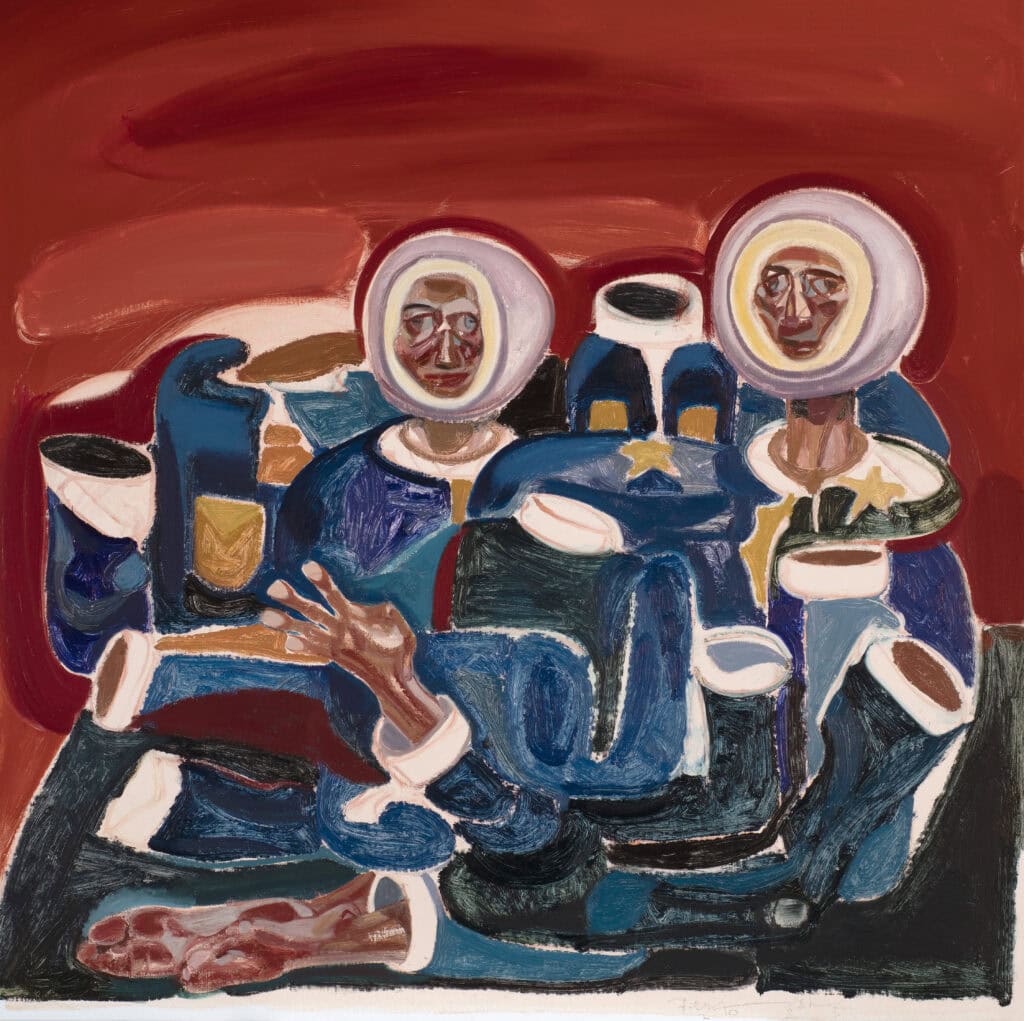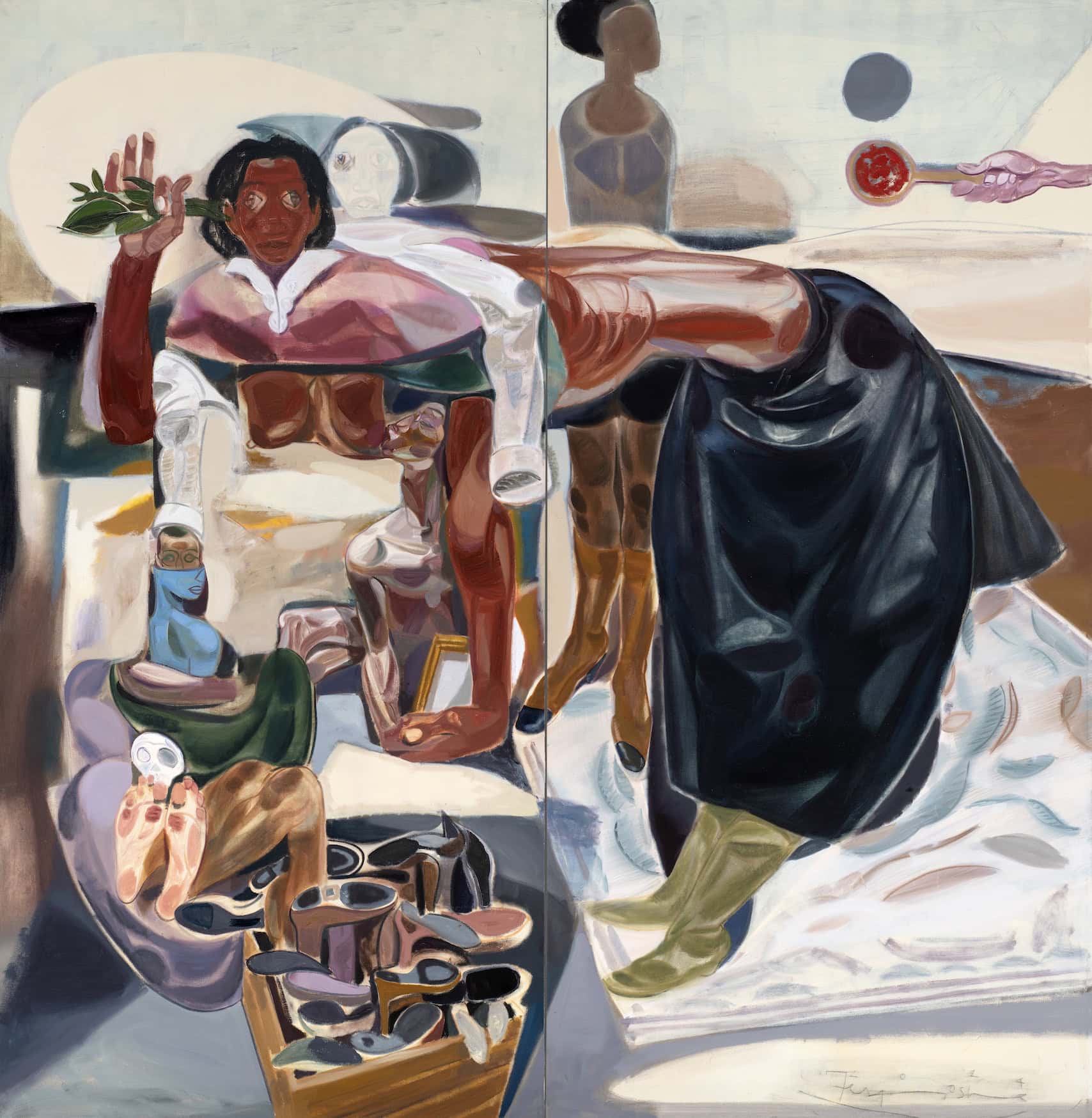This review originally appeared in the November 2025 issue of The Critic.
The Ethiopian painter Tesfaye Urgessa’s canvases assemble casts of larger-than-life characters in poses straight out of the art history textbook. In some images – rendered in abstract strokes and soft palettes – the artist’s subjects are still, as though enacting a religious allegory. In others, they adopt stilted walk-like-an-Egyptian geometries familiar from pre-Renaissance court painting. They are often partly unclothed and recognisable only by their disembodied limbs, although that does not take away from their plain dignity. Urgessa sets them at the dinner table, mid journey, or amidst a frenzied orgy, where they are, nonetheless, deep in dialogue with others out of the frame. Their interlocutors are sometimes found in the very next picture, sometimes in an altogether different museum.
If this sounds Delphic, that’s because it is. Urgessa’s conversation in oil paint echoes the fundamental questions of Modernity and the art that made it. Who owns our ideas, and who fixes them in images? The artist’s solo presentation at last year’s Venice Biennale – art’s mimetic marketplace of pictorial references – inaugurated the first-ever Ethiopian pavilion. His current exhibition at the Sainsbury Centre in Norwich, whose collection includes an array of works by twentieth-century European greats such as Francis Bacon and Alberto Giacometti but also West African tribal sculpture, now confounds projections of the Ethiopian’s lineage.
Like many of Urgessa’s extraordinary compositions, the two-panel First Flame (2025) is at once familiar and unknowable. It depicts a female figure distorted as if to occupy two incompatible geometries. She holds a bunch of flowers, signalling her readiness to take part in some ritual of courtship. Yet other elements she shares the canvas with – is that an artist nursing at her breast and are these human feet in a bucket?! – suggest that the game has already played out. This quasi-Surrealist scene sets Urgessa’s allusions as a cryptic puzzle. It’s hard not to recall Philip Guston here, for example – a single hand stretched from beyond the frame grips a red mirror with no reflection in Urgessa’s painting – but such correspondence could only be a decoy.
Urgessa learned to paint as a child by copying the religious imagery of Ethiopian Christianity, whose origins lie in the fourth century, before moving to study in Germany. The painter’s hand and concepts are, therefore, only partly guided by the Western art world’s barely concealed self-regard. His canvases address the religious icon as they do high Cubism. For example, Sky in a Shell (2025), which could (feasibly) depict the saints in an act of supplication, directly attests that Urgessa has not abandoned his formative impressions.

Indeed, many of his subjects gather in acts of communal witnessing. Such scenes are half prophecy, half expectation. The remarkable No country for young men, 31 (2024) – part of a series reflecting on mass migration – shows a dozen or so figures crammed together as if in a sardine tin or on what is euphemistically called a “small boat”. This image might be why the gallery clumsily crowbarred Urgessa’s show into a confusing activist programme of anti-war and climate change displays, but the work far surpasses such soundbite classification. Urgessa is more interested in his subjects’ knowledge – he has them hold on to manuscript books rather than life vests – than their personal attributes. He confronts them with enlightenment, too, before obscuring its source; multiple canvases show a scribe’s hands or the paraphernalia of artistic creation, yet many also distort the painter’s signature.
Untangling this jumble is aesthetically pleasurable, but ultimately vexing intellectually. That Urgessa presents these scenes in a style reminiscent of Picasso’s African period, for example, challenges the very possibility of accounting for the ownership of signs. The single-figure portrait Woman Combing Her Hair, After Picasso, hanging next to a twentieth-century wooden figure from the Ivory Coast, finally, explicitly reveals its influences. But in doing so, it contradicts Picasso’s chronology and his myth, which relies, in part, on breaking spurious civilisational taboos. Yet if Urgessa’s references and borrowings appear art historically incongruous, it is because, well, they might not be citations at all.

With envy-inspiring liberty, Urgessa addresses multiple traditions, rejecting the anxiety of provenance that characterises so much of today’s art and thought. There is a precedent to this, of course. Some of Urgessa’s group portraits are reminiscent of the photographs made by European ethnographers, like Images of the Pueblo Indians, which the father of art history, Abi Warburg, infamously presented in a 1923 lecture to secure his release from an insane asylum.
Urgessa toys with this tradition and thus with the gallery. In some paintings, his subjects’ relationship with the viewer is akin to a formal interrogation, such as might take place at the city’s border walls or a site of cultural transmission. And it is not clear who is interrogating whom. The doubt overcomes even the Sainsbury Centre’s overzealous attempt at smoothing out Modernity’s contradictions. To a viewer looking with one eye closed, Urgessa paints like a dead white man. Closing the other, a curator might even celebrate this quality.
Tesfaye Urgessa, Roots of Resilience continues at the Sainsbury Centre, Norwich, until 15 February.
Main image: Tesfaye Urgessa, First Flame, 2025, oil on canvas. © the artist.
